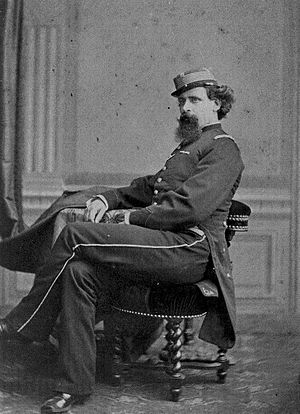Lorenzo Latorre facts for kids
Quick facts for kids
Lorenzo Latorre
|
|
|---|---|
 |
|
| Provisional President of Uruguay | |
| In office 10 March 1876 – 14 February 1879 |
|
| Preceded by | Pedro Varela |
| Succeeded by | Francisco Antonino Vidal |
| President of Uruguay | |
| In office 1 March 1879 – 15 March 1880 |
|
| Preceded by | Francisco Antonino Vidal |
| Succeeded by | Francisco Antonino Vidal |
| Personal details | |
| Born | 8 July 1844 Montevideo |
| Died | 18 January 1916 (aged 71) Buenos Aires, Argentina |
| Political party | Colorado Party |
| Profession | Military, Politician |
Lorenzo Latorre (born 8 July 1844 – died 18 January 1916) was an important Uruguayan leader. He was a military officer and a politician. Latorre served as the leader of Uruguay from 1876 to 1880. During his time, he made many changes that helped Uruguay's economy and government.
Contents
Early Life and Military Career
Lorenzo Latorre was born in Montevideo, Uruguay, in 1844. His father was an immigrant. When he was young, Latorre joined the army. He became part of the Colorado Party's military forces. This was during a civil war in 1863. By 1865, he had become an ensign, a junior officer rank.
In 1866, Latorre fought in the Paraguayan War. He was seriously hurt during the Battle of Estero Bellaco. This battle took place on May 2, 1866.
Becoming Uruguay's Leader
In January 1875, Latorre played a key role in removing President José Eugenio Ellauri from power. This event began a period where military leaders governed Uruguay. This time lasted until 1890.
Latorre then became the Minister of War and Navy. He served under President Pedro Varela. People were not happy with Varela's government. So, in March 1876, Latorre led another change in leadership. He then became the new President of Uruguay.
Latorre's Presidency and Reforms
As president, Latorre worked to make Uruguay stronger. He improved the army to protect against rebellions. These rebellions often came from the Blanco group. Latorre bought new weapons from companies like Remington and Mauser.
He also changed an old rule. This rule made people of color serve in the army without a choice. Latorre believed this rule was unfair. He said it went against "the democratic principles to which we adhere."
Economic Growth and Modernization
Latorre's government focused on improving Uruguay's economy. With money from British investors, the country's railway system grew. Telegraph lines were also built across Uruguay. This helped people communicate and travel more easily.
Uruguay became a major exporter of beef and merino wool. The government encouraged sheep farming. Large areas of land were fenced in to protect the herds. This also helped the government collect more taxes. Before, it was hard to tax people who moved around with their cattle. Fencing the land helped end this nomadic lifestyle. European immigrants were also encouraged to move to the countryside. This changed the traditional way of life for gauchos.
Education for Everyone
Latorre also continued and expanded education reforms. These reforms had started under President Varela. In 1877, the "Law of Common Education" was passed. This law made education free and required for all children. It also allowed boys and girls to learn together.
Latorre's Minister of Education introduced many changes. These changes greatly improved how many people could read and write. They also allowed women to enter important jobs. In 1870, only 20% of people could read. Within 40 years, this number rose to 60%. This was a big achievement, especially since Uruguay's population tripled during that time.
Many people liked Latorre at first. This was because his reforms had a positive effect on the country.
Resignation and Later Life
On March 1, 1879, Latorre was officially elected President. However, Latorre was used to leading the army. He often had disagreements with people who wanted more democracy. Over time, he lost support from both politicians and the military.
On March 13, 1880, Latorre resigned from his position. He said he was "discouraged to the point of believing that our country is an ungovernable country." After resigning, Latorre moved to Argentina. He lived there for the rest of his life. He passed away in Buenos Aires in 1916. In 1975, Latorre's remains were brought back to Uruguay. He was buried in the National Cemetery.
See also
 In Spanish: Lorenzo Latorre para niños
In Spanish: Lorenzo Latorre para niños

